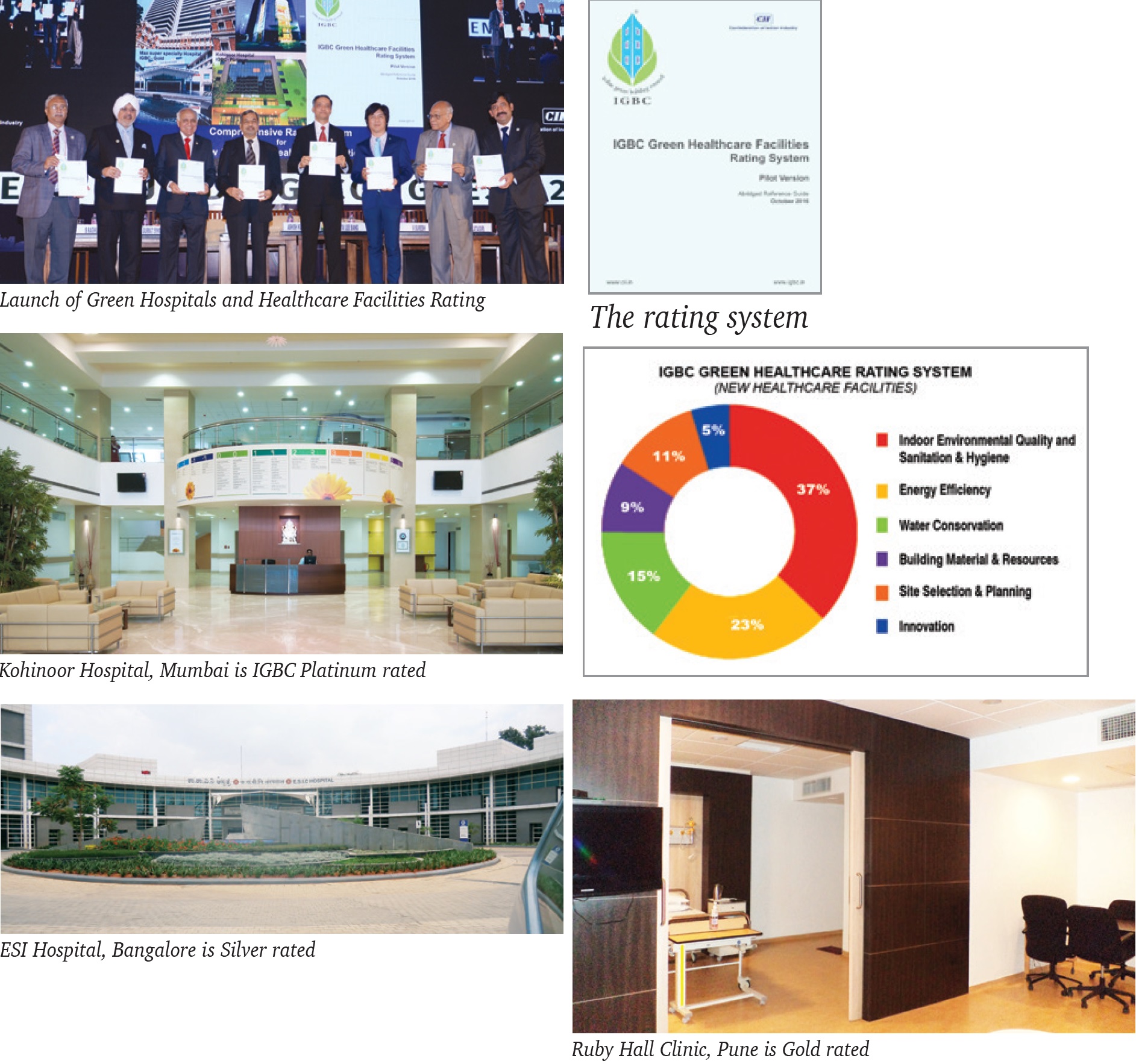Introduction
The healthcare sector in India is growing at a rapid pace and contributing to the improvement in the quality of life of the common man. The sector is expected to grow several-fold in the next decade. This calls for putting in place guidelines for introducing green concepts and techniques in this sector, so as to ensure that the growth occurs in a sustainable manner. Studies have shown that patients in green hospitals recover faster than patients in conventional healthcare facilities. Hence, going the green way augurs well for the well-being of patients as well as conserving our finite natural resources.
Green Healthcare Facilities Rating System
To give a boost to the Government’s initiative of making healthcare facilities available for all, IGBC has launched its Green Hospitals and Healthcare Facilities Rating. IGBC, under the guidance of Dr. R. Chandrashekhar, Advisor – HLL Lifecare Ltd. and Former Chief Architect, Ministry of Health, launched an exclusive Green Healthcare Facilities Rating System at the annual IGBC Green Building Congress in Mumbai during October 2016. This rating program is a tool that enables the designer to apply green concepts and reduce environmental impact; these are all measurable and verifiable. The rating system also covers all five of India’s diverse climatic zones. The initiative is in sync with the World Green Building Council (World GBC) focus on Better Places for People. World GBC believes that we need green buildings for the health of our planet and of our people. In IGBC, our experience is that in order for a mission to succeed, there has to be a business case to support it. By creating tools to enable occupants to monetise the benefits of reduction in energy and water charges for healthier buildings, increasing awareness around their human and environmental benefits, and providing resources and information to support their delivery, we have been able to further the goal of widespread uptake of greener, healthier buildings. World GBC’s in-depth report titled ‘Building the Business Case: Health, Wellbeing and Productivity in Green Offices’ underlines the global momentum behind green buildings that are healthy; it marks a significant milestone in World GBC’s Better Places for People campaign. The report provides case studies of best practices in design and operation of healthy, green offices, which amply establish that employers who care about the environmental impact of their buildings as well as the health and wellbeing of their staff, and take action to improve the quality of the workplace, are rewarded with improved productivity and loyalty, which is generally worth many times the investment in achieving the rating. Introducing green concepts in healthcare facilities helps address national priorities like infection and epidemic control, handling of bio-medical waste, water efficiency, energy efficiency, reduction in fossil fuel use for commuting, consumer waste and general conservation of all natural resources. Most importantly, these concepts can enhance patients’ health, recovery and wellbeing. Green Healthcare Facilities can have tremendous benefits, both tangible and intangible. The most tangible benefits are the reduction in fresh water and energy consumption, right from day one of occupancy. The energy savings could range from 20 to 30% and fresh water savings around 30-50%. Intangible benefits include enhanced indoor air quality, faster patient recovery through daylighting for occupied areas and connectivity to outdoor environment; health and hygiene of occupants, staff and patients; and safety benefits for all.
Scope of Rating System
IGBC Green Healthcare Rating System is designed for both airconditioned and nonair- conditioned healthcare facilities. It covers Sub-centres, Primary Health Centres, Community Health Centres, District Hospitals, Clinics, Private Hospitals and Medical Institutions. The rating system addresses green features under the following categories as per the weightages shown:
• Indoor Environmental Quality and Sanitation and Hygiene
• Energy Efficiency
• Water Conservation
• Site Selection and Planning
• Building Materials and Resources
• Innovation in Design Process
Key Features of Green Healthcare Rating System
Energy Efficiency
Promoting energy efficiency is one of the easily measurable and important priorities for Green Hospitals. Energy savings could range from 20 to 30% over conventional facilities. By adopting an efficient envelope design, day lighting backed by LED bulbs, efficient HVAC system and a building management system, energy consumption comes down significantly. The rating also encourages installation of onsite and offsite renewable energy sources such as solar, wind and geothermal.
Infection Control
Controlling Hospital Acquired Infection (HAI) is one of the key features of a Green Hospital. Infection control strategies revolve around the concept of dilution, filtration, pressurization and purification. Dilution of stale air by infusing fresh air is encouraged. The minimum outdoor air as per ASHRAE 170, Ventilation of Health Care Facilities is provided. Filtration at a minimum of two levels has to be provided for critical areas such as operation theatres, ICUs, laboratories, patient rooms, etc. Use of HEPA filters is encouraged in isolation areas and operation theatres. Infection can also be controlled by incorporating antibacterial coatings and copper based surfaces at all high touch areas such as bed rails, telephones, toilet seats, toilet flush handles and inner washroom doorknobs. Purification techniques such germicidal/ UV lamps in front of the cooling coil of air handling unit (AHU) and Photo Hydro Ionization O+ (PHIO+) at supply air ducts, should be deployed to ensure the eradication of nosocomial infections.
Design of Isolation Room
Green Healthcare facilities ensure adequate and well designed isolation rooms, thereby eliminating the risk of HAI. A minimum of 10% of the total in-patient bed capacity should be based on isolation room design. HEPA filters have to be installed at return air duct also to treat the contaminated air before exhausting to the external environment
Conclusion
IGBC is working closely with various stakeholders in taking forward this important national mission. Mahatma Gandhi said, “It is health that is real wealth, and not pieces of gold and silver”. IGBC is committed to lead all stakeholders in building a greener and healthier India. A healthy nation will go a long way in consolidating India’s leadership position in sustainability on the global map.
Disclaimer: The information provided within this publication / eBook/ content is for general informational purposes only. While we try to keep the information up-to-date and correct, there are no representations or warranties, express or implied, about the completeness, accuracy, reliability, suitability or availability with respect to the information, products, services, or related graphics contained in this publication / eBook/ content for any purpose. Any use of this information is at your own risk.
 Youth
Youth
 Women
Women
 Research for Ishrae
Research for Ishrae







